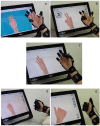Efficacy of Short-Term Robot-Assisted Rehabilitation in Patients With Hand Paralysis After Stroke: A Randomized Clinical Trial
- PMID: 28719996
- PMCID: PMC5755871
- DOI: 10.1177/1558944717692096
Efficacy of Short-Term Robot-Assisted Rehabilitation in Patients With Hand Paralysis After Stroke: A Randomized Clinical Trial
Abstract
Background: We evaluated the effectiveness of robot-assisted motion and activity in additional to physiotherapy (PT) and occupational therapy (OT) on stroke patients with hand paralysis.
Methods: A randomized controlled trial was conducted. Thirty-two patients, 34.4% female (mean ± SD age: 68.9 ± 11.6 years), with hand paralysis after stroke participated. The experimental group received 30 minutes of passive mobilization of the hand through the robotic device Gloreha (Brescia, Italy), and the control group received an additional 30 minutes of PT and OT for 3 consecutive weeks (3 d/wk) in addition to traditional rehabilitation. Outcomes included the National Institutes of Health Stroke Scale (NIHSS), Modified Ashworth Scale, Barthel Index (BI), Motricity Index (MI), short version of the Disabilities of the Arm, Shoulder and Hand (QuickDASH), and the visual analog scale (VAS) measurements. All measures were collected at baseline and end of the intervention (3 weeks).
Results: A significant effect of time interaction existed for NIHSS, BI, MI, and QuickDASH, after stroke immediately after the interventions (all, P < .001). The experimental group had a greater reduction in pain compared with the control group at the end of the intervention, a reduction of 11.3 mm compared with 3.7 mm, using the 100-mm VAS scale.
Conclusions: In the treatment of pain and spasticity in hand paralysis after stroke, robot-assisted mobilization performed in conjunction with traditional PT and OT is as effective as traditional rehabilitation.
Keywords: hand; rehabilitation; robotic; stroke; wearable.
Conflict of interest statement
Figures



References
-
- Aggogeri F, Borboni A, Faglia R, et al. Precision positioning systems: an overview of the state of art. Appl Mech Mater. 2013;336-338:1170-1173.
-
- Andringa AS, Van de, Port IG, Meijer JW. Tolerance and effectiveness of a new dynamic hand-wrist orthosis in chronic stroke patients. NeuroRehabilitation. 2013;33:225-231. - PubMed
-
- Balasubramanian S, Klein J, Burdet E. Robot-assisted rehabilitation of hand function. Curr Opin Neurol. 2010;23:661-670. - PubMed
-
- Bishop L, Stein J. Three upper limb robotic devices for stroke rehabilitation: a review and clinical perspective. NeuroRehabilitation. 2013;33:3-11. - PubMed
Publication types
MeSH terms
LinkOut - more resources
Full Text Sources
Other Literature Sources
Medical

